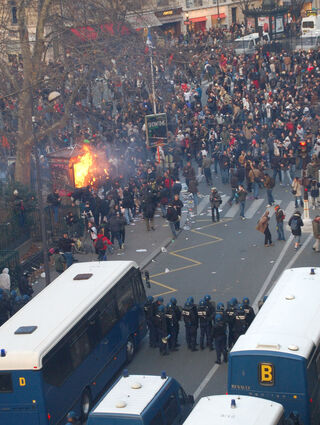Experts Use This Trick to Transform Conflicts
CONFLICT RESOLUTION - MEDIATION, 22 Feb 2021
Matthew Legge | Psychology Today - TRANSCEND Media Service
When we see the other side as the problem, it limits our thinking.
17 Feb 2021 – A lot of the analysis we get of current events, like the attempted insurrection in Washington, shares frightening details that can make problems sound impossible to address.

Too much of the coverage of conflicts of all types avoids key questions like “How might this conflict be transformed?” or “What efforts to constructively address this conflict are already happening?” Journalists don’t need to have answers to these questions, they just need to seek out and ask a range of people with relevant perspectives and expertise.
Given that, over and over, we’re exposed to shallow and terrifying presentations of conflicts, it’s no wonder that many of us are so good at evaluating others and figuring out what’s wrong with them. We can (we imagine) judge what sorts of personality disorders they have, or how their religion, race, or education are to blame for the behaviors we don’t like.
I’m not going to argue about whether these evaluations are factually right or wrong. Of course, they can be interesting and sometimes they give us important insights. There’s certainly a place for them.
All I’ll point out is this: They’re merely one possible approach. We can equally choose to interpret conflicts in endless other ways that will also help explain them. That’s because there are always many factors at play. So it’s up to us what factors we choose to zoom in on and what we choose to ignore.
When making this choice, an important question arises. Amazingly, this question is regularly overlooked as we try to understand conflicts: What will this get me? What’s the result of this analysis I’m making? What does it wind up doing?
My answer, from following all sorts of bitter conflicts in various countries, is this: The most consistent result of the negative evaluations we make of people we disagree with is to make them the problem.
But I believe that any time you see other people as the problem, your analysis has failed you. Why?
Well if they’re the problem, the first solution many of us think of is to get rid of them.
This logic is reflected in a 2017 survey done in the US. One question was “Do you ever think we’d be better off as a country if large numbers of [Opposing party] in the public today just died?” Twenty percent of Democrats and 15 percent of Republicans said “yes.” (When it comes to actual policies they support, these folks aren’t nearly as far apart as they assume.)
If getting rid of the other side seems a bit too extreme, then we at least want to silence and marginalize them as much as possible. We hope they’ll just fade into the background. But in large-scale societal conflicts, that’s never going to happen. The other side will not just disappear.
Even if we don’t dehumanize and wish death on the other side, if we recognize that they aren’t going to disappear, even if we try to be very careful and reasonable, when our analysis leads us to see other people as the problem, there are only a few possible solutions. We can give up and disengage, quietly suffer along with the behavior we dislike or, somehow or other, try to make them change.
In trying to force people to change, we cite facts at them or shout about why they’re the problem. But I think these are mostly last resorts. We don’t hold out much hope that they can work, we just lack ideas about what else to try. So we make ourselves feel better by feeling worse about them, assuring ourselves that they’re the problem (meaning we aren’t the problem and don’t need to change anything we’re doing). Our moral outrage is also incentivized because it can win us points with our group.
No doubt if you could somehow force the other side to change their entire belief system the conflict wouldn’t be what it is. If the person you can’t stand and are sure has a mental health issue that’s making them so intolerable went to therapy and dramatically altered their personality, that would transform your conflict. But that’s a pretty naive expectation. It hardly seems likely in every disagreement you get into.
So what other choices can we make when analyzing conflicts?
Try this the next time you’re upset with someone, whether it’s a politician, a family member, or somebody on social media: Take the idea that they’re the problem off of the table. Get rid of it.
You don’t get to focus on what’s wrong with them as a person. You can easily come up with answers to that question (and they may be oh-so-satisfying answers!), but those are now off limits.
With the simplistic explanation removed, what do you find? Try again to interpret the situation.
What you’re likely to discover is that you can, if you make an effort, find complexity at play.
When you aren’t asking, “What’s wrong with this person?” you can uncover many factors contributing to the conflict. That doesn’t make what the other side is doing moral or acceptable. It doesn’t remove the need for accountability. But it can make you more creative.
When you see the problem not as all about them, you’ve got more options. You’re more powerful. This is a trick that experts in transforming conflicts use all the time.
If we focus on this question of what are the unmet needs, we can regularly find ways to work together. I’ve collected many startling and successful examples—even one of courageous gay people in Kenya successfully engaging with priests and imams who were wishing death on them!
In short, changing the framing of the issue can be incredibly effective. Drop the “I’m right and something about you makes you the problem.” Move from this “me versus you” to “me and you versus the situation to be transformed,” and you will have powerful new levels of understanding at your disposal.
Of course, not every need can be met and not every relationship can be healed. But pessimism about how much is possible readily leads to confirmation bias and self-fulfilling prophesies. We don’t even try to find out what the other side’s unmet needs are because we assume that “those people” are just impossible-to-reach fanatics.
But if you pause and shift from the mindset of “me versus you” to “me and you versus the situation to be transformed,” you won’t feel as afraid and threatened. This will broaden your perspective, and you’ll benefit.
________________________________________________
Matthew Legge is the author of Are We Done Fighting? Building Understanding in a World of Hate and Division. He is a Peace Program Coordinator at Canadian Friends Service Committee.
Tags: Conflict, Conflict Analysis, Conflict Mediation, Conflict Resolution, Conflict Transformation
DISCLAIMER: The statements, views and opinions expressed in pieces republished here are solely those of the authors and do not necessarily represent those of TMS. In accordance with title 17 U.S.C. section 107, this material is distributed without profit to those who have expressed a prior interest in receiving the included information for research and educational purposes. TMS has no affiliation whatsoever with the originator of this article nor is TMS endorsed or sponsored by the originator. “GO TO ORIGINAL” links are provided as a convenience to our readers and allow for verification of authenticity. However, as originating pages are often updated by their originating host sites, the versions posted may not match the versions our readers view when clicking the “GO TO ORIGINAL” links. This site contains copyrighted material the use of which has not always been specifically authorized by the copyright owner. We are making such material available in our efforts to advance understanding of environmental, political, human rights, economic, democracy, scientific, and social justice issues, etc. We believe this constitutes a ‘fair use’ of any such copyrighted material as provided for in section 107 of the US Copyright Law. In accordance with Title 17 U.S.C. Section 107, the material on this site is distributed without profit to those who have expressed a prior interest in receiving the included information for research and educational purposes. For more information go to: http://www.law.cornell.edu/uscode/17/107.shtml. If you wish to use copyrighted material from this site for purposes of your own that go beyond ‘fair use’, you must obtain permission from the copyright owner.
2 Responses to “Experts Use This Trick to Transform Conflicts”
Read more
Click here to go to the current weekly digest or pick another article:
CONFLICT RESOLUTION - MEDIATION:

I appreciate your article very much. Here is an excerpt from my editorial in this issue, also check out my last piece, also on Medium Abracadabraism, at the end I make a similar point. https://dianeperlman-24337.medium.com/abracadabraism-trump-not-exactly-lying-6a05f7ae70e9
“Never fight evil as if it were something that arises totally outside of yourself.” — St Augustine
“My partial diagnosis: White supremacy is deeper than race. It’s about intolerable affects from loss of status, fear, envy and humiliation, grief, being unheard, forgotten and replaced. The Charlottesville cry, “Jews will not replace us” was not properly analyzed. Elitist Dems left a gaping, painful void that Trump easily filled with poison. We must collaborate to fill it with remembering, listening and healing.
Jamie said, “they’re our children, too.” Trump’s base are part of us, relegated to our shadow which when denied erupted into collective consciousness.
Rabbi Abraham Joshua Heschel, who “prayed with his feet” marching with Martin Luther King said,
“Few are guilty, but all are responsible.” And, “It is an act of evil to accept the state of evil as either inevitable or final.”
Thank you for your comments and sharing your many insights from your Medium post, Diane!